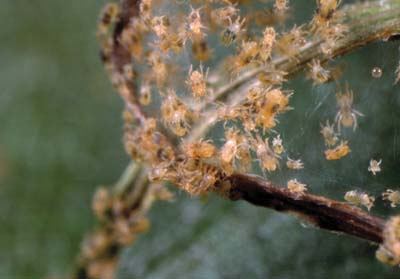To save the Web-optimized images shown below to your hard drive:
|
Click to access Display and Print quality images. |
Damage can be intensified because of the overlap of generations. The presence of spider mites results in webbing on leaves, and stippling and curling of leaves. Complete defoliation may occur if spider mites are left uncontrolled. Plants should be inspected weekly for spider mite damage. A number of identified predators can provide sufficient control under some conditions. Miticides must be used sparingly due to the ability of the twospotted spider mite to develop resistance. Insecticidal oils and sulfur are commonly used to manage mite populations in greenhouses. They thrive under drought conditions so frequent overhead watering may help to suppress mite populations.
Images
To save the Web-optimized images shown below to your hard drive:

Twospotted spider mite, Tetranychus urticae, on webbing.
(Photographer: J. Castner, University of Florida)
Click to access Display and Print quality images.
|
Click to access Display and Print quality images. |
|
Click to access Display and Print quality images. |
|
Click to access Display and Print quality images. |